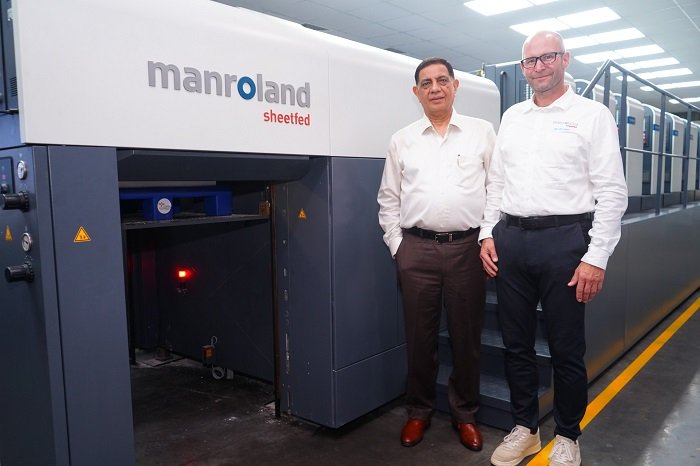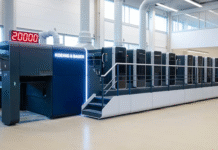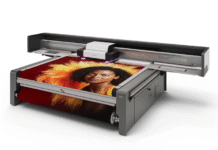Manroland Sheetfed India inaugurated its new office in Dwarka, New Delhi on the morning of 9 September 2025. The event was attended by Mirko Kern, CEO of Manroland, Deepak Walia, managing director of Manroland Sheetfed India, the company’s team of engineers, technicians, and members of the press.
The discussions revolved around Manroland’s growing presence in India through new Evolution press installations, the increasing demand for new equipment and automation. the company’s strength in installation, training and after-sales service were discussed. The free ranging open discussion took up the increasing understanding of the need for automation in improving efficiency, the reshaping of the book printing industry, and tariff challenges affecting the global industry and business dynamics.
Mirko Kern reiterated India’s rising importance in Manroland’s global strategy, something that he had first said to us at Printpack India in February of this year. “India is a very important market for us. My frequent visits here show how seriously we value it,” he said. The company has made consistent progress in the region, with multiple installations over the last three years of its Evolution presses as well as good condition used highly configured presses.
Kern highlighted that India has seen 16–17 Manroland installations in recent years, with both new and refurbished presses finding acceptance. Further, Walia pointed out that, while customers traditionally leaned toward new presses, the acceptance of high-quality used equipment has also grown.
Walia noted that Manroland India has doubled its growth in value terms in the last three years. “We have a huge scope to grow. Even if our machine numbers are not high, the value contribution is significant, and we are profitable year on year,” he said.
Vijay Kumar, head of service, Manroland sheetfed said that the company has built a team of 14 engineers, most of whom have undergone rigorous training at the Offenbach headquarters in Germany adjacent to Frankfurt. Customer service programs such as ProServ 360 have further boosted confidence, minimizing breakdowns and ensuring preventive maintenance. Walia stressed that service responsiveness is one of the company’s biggest differentiators in India.
According to Walia, with automation reducing make-ready times from 15 minutes to as low as 6–7 minutes, print shops are increasingly recognizing the long-term benefits of investing in advanced presses. With growing pressure on turnaround times, efficiency, and profitability, automation in sheetfed offset printing is becoming indispensable.
Walia pointed out that Indian customers are beginning to embrace features such as inline cold–foil application, logistics, and auto-check systems. However, he acknowledged that cultural and mindset shifts are needed. “Some still think a 15-minute make-ready versus 6 minutes makes no difference. But when the market moves to 3–4 minutes, they will follow. India will buy automation, maybe in another 4–5 years, in a big way,” he predicted.
The book printing momentum
The book printing segment in India is undergoing a notable transformation. According to Walia, printers who previously relied heavily on secondhand presses are now maturing to a point where investing in new presses has become both necessary and viable. Many publication printers own fleets of four to ten multicolor machines, often older long presses, and are now ready to invest in advanced presses and 8–color perfecters.
Walia further commented that this shift has already led to a significant uptake of new eight-color perfecting presses. Currently, India has crossed into double-digit installations. Leading publication printers have been at the forefront of these investments.

He noted that 8–color perfecting presses with advanced automation features are critical for publishers to stay competitive, particularly in export markets. Short-run jobs, which in India can range from 20 to 60 million impressions annually for leading book printers, demand efficiency and consistency that only the latest automated presses can deliver. While some printers still opt for entry-level presses without automation, Walia emphasized that the real competitive advantage lies in adopting technology-rich systems that can enhance productivity, reduce downtime, and ensure high-quality output.
He highlighted that events such as the Frankfurt Book Fair are expected to showcase a growing presence of Indian publishers and printers seeking to expand into global markets. According to him, print production that is less time-sensitive is likely to shift more and more to India, leveraging its competitive costs. However, to succeed internationally, printers must invest in modern 8–color presses with automation to match the output and quality standards of global competitors.
Tariff hurdles
Kern in the press meeting highlighted a cautious note when speaking about global trade dynamics, particularly the recent tariffs. He explained that the tariffs are a major challenge in markets such as the United States, where import duties on German and Japanese printing presses have risen sharply in recent months.
“The main problem is that the tariff is only valid when the machine enters the country. So if we sign a contract today for a machine worth a few million euros, the customer does not know what the final tariff will be when it arrives in 6–9 months. It could be 5%, 10%, or 15%. On a €3–4 million machine, that uncertainty makes a huge difference,” Kern said. This unpredictability, he admitted, has dampened investments by printers in the US market.
On India’s trade policy front, Kern welcomed the ongoing EU–India Free Trade Agreement (FTA) negotiations, which could potentially reduce tariffs on heavy machinery imports. “If the tariffs come down, it will be a big movement for us. India is already one of the most important markets for us globally, and such a step would accelerate investments,” he added.
Manroland Sheetfed’s leadership emphasized that despite tariff concerns globally, the company remains optimistic about its India prospects. The demand for new presses, coupled with interest in used machines, ensures a broad market base. With automation expected to play a transformative role in the coming years, Manroland aims to broaden its presence.
As Walia concluded, “Our growth is sustainable because it is profitable. The scope in India is huge, and with the right mix of machines, service, and consumables, we will continue to strengthen our presence.”
Financial viability and global markets
On the financial front, Kern acknowledged that 2025 has been challenging. While the first quarter exceeded expectations, a slowdown in China – the world’s largest printing market – has impacted global numbers. Trade uncertainties with the US, coupled with lower GDP growth in China, have added to the cautious outlook. Still Kern remains optimistic. For South Asia, the company’s primary focus remains India, while service business exists in Nepal and some opportunities may arise in Nepal, Bangladesh, and Sri Lanka.
Understandably not everything in the world has gone as Manroland Sheetfed president Mikko Kern’s hoped at the Printpack India exhibition in February. But the emphasis on the Indian market and the company’s commitment to it, visible at that event, is showing results. After Kern inaugurated the new Manroland Sheetfed India office he went on to inaugurate the new Evolution 8–color perfecter at Replika Press, just an hour north of the city.

















